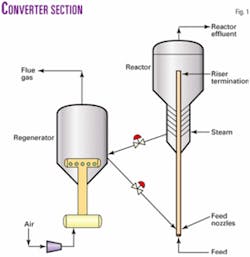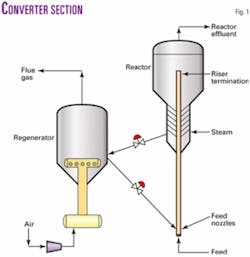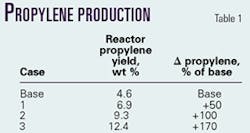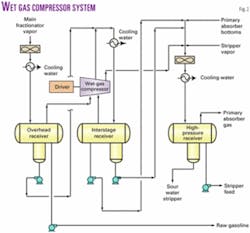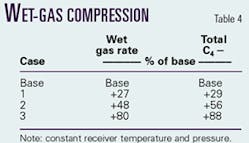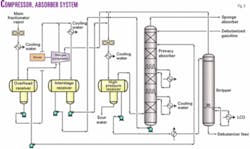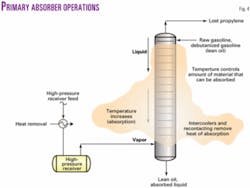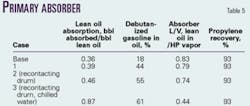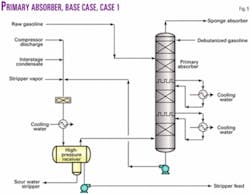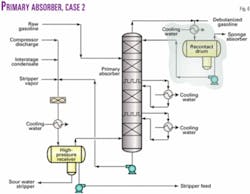Higher propylene yields from FCC units require higher reactor temperature and changes in the catalyst system. It is important that the plant operator concurrently evaluate reactor yields, wet-gas compressor, and gas-plant performance to determine the most cost-effective revamp strategy.
Saudi Arabian Oil Co. (Saudi Aramco) evaluated four reactor case studies to determine the effect of different high-propylene-yield catalyst formulations on downstream equipment.
Propylene is one of the fastest growing petrochemical feedstocks. Projected to exceed traditional supply from steam crackers, worldwide demand is forecast to increase 6 %/year during the next 20 years, due mainly to a growing need for polypropylene, acrylonitrile, and phenolic resins.
To take advantage of this growth, some refiners are revamping their FCC units to increase propylene while also producing more C4 olefins for alkylate production. To avoid incurring excessive investment costs, however, reactor C4-minus yields must balance the existing process and equipment constraints.1 2
This article examines basic changes in the converter section (Fig. 1), but also emphasizes the need to make fundamental changes in the process design and equipment in the product-recovery section. Increasing C4-minus yields from the reactor is only half the story; it is just as important to know how to compress, cool, and recover the additional light products.
As with any revamp, one must quantify all current plant limits to identify the areas requiring investment early in the process. Otherwise, engineering efforts will be wasted. Because every FCC has unique constraints, comprehensive data including field measurements are needed to assess true performance.3 Only then can one develop a realistic revamp scope to ensure that recovery cost does not exceed capital limits.
Propylene yield
Saudi Aramco generated four reactor yield cases based on in-house FCC technology development, pilot-plant work, catalyst testing, and actual unit yields. The feed was an unhydrotreated 650-1,000° F. gas oil produced from Arab Light crude.
Reactor yields were run through a process flow model with a typical FCC product recovery system. As reactor propylene yield increased from the base case, higher equipment system loads required fundamental process design changes and increases in major equipment capacity to maintain propylene recovery. Greater propylene yields4 requires changes in both the converter (reactor-regenerator) and downstream product-recovery sections.
In the study, propylene yields ranged from typical (4.6 wt %) using a conventional cracking catalyst to high (12.0 wt %) with an optimized catalyst formulation (Table 1). These yield shifts represent the range of recent revamps and highlight some of the more important converter and product-recovery section design considerations.
When propylene yields increase, major converter changes, such as those to the air blower and cyclones, must be minimized. Limiting revamp capital investment costs also applies to downstream recovery because raising propylene yield also increases total C4-minus production, resulting in higher wet-gas compressor, cooling, and gas plant loads. Because each FCC unit has unique process and equipment limits, individual solutions will vary.
Greater C3 and C4 production always influences specific systems because each FCC has given limits. In one recent revamp, for example, the converter section required a new catalyst system and higher temperature to raise propylene yields. This was accomplished with a minimal increase in coke make, as is often the case when managed properly with catalyst changes. The product-recovery section required most of the capital investment. Because available capital rather than return-on-investment constrains many revamps, a knowledge of these capital limits and projecting reliable order-of-magnitude costs in early stages of engineering will prevent waste of time and money in considering reactor yield cases that have no reasonable chance of implementation.
For instance, if capital investment is limited to only $10 million and a new wet-gas compressor is needed, little or no money remains to address other bottlenecks. Producing more propylene from the reactor may not cost much, but capturing the incremental yield without losing recovery is rarely possible without some investment.
Reactor yields
During a new unit's design, yields establish the design and technology of the converter section, main fractionator, compression system, and gas plant, and define broader concerns such as energy efficiency and heat integration5 between the main column and gas plant.
Reactor yields influence air blower and compressor size, gas-plant operating pressure, primary absorber lean oil rates, and other design parameters. The designer develops equipment specifications and purchases new equipment.
In a grassroots design, there is no existing equipment to influence designers' decisions. In a revamp, however, the most cost-effective strategy depends to a large extent on actual existing process and equipment limits. Measuring real equipment and overall unit performance is therefore essential in identifying constraints to circumvent or eliminate. The first task is a comprehensive test run with actual measurements. Only then can the revamp engineer realistically assess the reactor yield cases that are viable within capital limits.
Converter section
Increasing propylene yield requires higher riser temperature (ROT) and catalyst:oil ratio, different catalyst formulation, and possibly reactor hardware modifications (Fig. 1).
Large ROT increases (+50° F.) are needed to materially raise propylene yield, but this also produces large amounts of dry gas, which makes recovery costly. At some ROT, the rate of gasoline cracking will exceed the rate of gasoline production, which reduces FCC gasoline yield. At this point, gasoline begins to crack to make more propylene.
In our example, we use reactor temperature and a new catalyst system to increase propylene yield from the base case (Table 2).
At temperatures greater than the gasoline overcracking temperature, the amount of propylene produced per unit conversion will increase as more gasoline is cracked. Because gasoline overcracking also produces more C4 olefins that can be alkylated, increases in alkylate yield will offset the FCC gasoline yield loss while raising overall gasoline pool octane, if unit capacity exists.
Catalyst basics
FCC cracking catalysts contain two components: zeolite and matrix. Each plays a role in overall performance.
The primary component for selective cracking is a faujasite-type zeolite, which can be modified substantially to alter its activity, product selectivity, and product qualities.
Adjusting the rare earth content to control activity and hydrogen-transfer reactions increases olefin yield at the expense of gasoline. Various manufacturing treatments also affect these characteristics.
The matrix component contains an active cracking matrix, clay, and binder. The matrix has a porosity structure that facilitates diffusion of feedstock molecules to the zeolites; its active sites crack the molecules that are too large to enter the pores.
The active matrix tolerates metals and contains traps for vanadium and nickel, which helps maintain zeolite activity and selectivity when processing resids or other high-metal feeds. The clay is an inert component that provides the physical integrity for density, fluidization, and heat-transfer properties, and particle size distribution.
The binder can be inert or possess some activity similar to the matrix. It holds the other components together as uniform microspheroidal particles that can withstand the aggressive conditions in the reactor and regenerator.
The ZSM-5 catalyst additive, which ExxonMobil Corp. developed, contains a proprietary shape-selective zeolite and is a member of the pentasil family of zeolites. The small pores of these shape-selective zeolites allow C6-C12 straight chain olefins and paraffins in the gasoline boiling range to enter where they are preferentially cracked into propylene and butylenes. The new generation of ZSM-5 additives has been stabilized to better maintain activity. Improved manufacturing techniques and higher levels of ZSM-5 in the particles have increased concentrations in unit catalyst inventory without deleterious effects on catalyst cracking activity. This higher zeolite content, along with higher ROT, increases light olefin yields.
Optimized primary cracking catalyst and ZSM-5 technologies provide the specific catalyst systems to achieve more light olefins (C3-C4) and good gasoline yield. Custom-tailored systems help address specific feedstock and process equipment constraints.
Case study, catalyst selection
The catalyst system used in the base case is a typical octane-enhancing catalyst containing a low rare-earth-exchanged USY zeolite.
Its unit cell size is small (24.18-24.21 Å), which promotes minimal hydrogen-transfer reactions. This results in a high C3-C4 and heavier olefins yield in the gasoline boiling range. It also results in a greater gasoline octane due to high heavier olefin content, but with a corresponding lower gasoline yield. This catalyst has some added matrix for extra bottoms cracking.
The new catalyst system for Cases 1-3 contains a primary cracking catalyst that has been moderately rare earth stabilized and specially treated to enhance hydrothermal stability and high selectivity for C3-C4 and gasoline olefins.
An additional selective matrix allows for enhanced diffusion of feed molecules and precracking on exposed zeolite, resulting in both olefins and bottoms upgrading. The reactor, therefore, yields more propylene and C4 olefins.
This catalyst is intrinsically more active than the base catalyst system and promotes similarly low hydrogen-transfer activities even though rare earth levels are slightly higher. It permits the use of high levels of new ZSM-5 additive without reducing circulating activity significantly.
The new generation ZSM-5 additive is chemically stabilized with more zeolite in the particles. This approximately doubles additive activity for producing propylene.
Product recovery system
Reactor effluent enters the main column where light cycle oil and heavier products are fractionated.
Because the majority of the C4-minus components do not condense in the main column overhead receiver, they must be compressed, cooled (Fig. 2), and then recovered, and finally fractionated in the gas plant. Consequently, the compressor, condensers, reboiler, and gas-plant column loadings all increase as the amount of C4-minus yields increase. In most revamps, these areas need some capital investment to recover the propylene.
Table 3 summarizes the C4-minus yields for each case and the relative changes from the base case. Because the wet-gas compressor is a likely high-cost investment area, determining required changes early is essential.
At a constant main column overhead receiver temperature and pressure, the wet-gas rate and total reactor C4-minus yields are directly related (Table 4). There is nearly a one-to-one relationship between reactor incremental C4-minus yield and wet-gas rate.
Materially increasing C4-minus yield will require some investment to debottleneck the compressor; the real question is how much.
Adding a new compressor and ancillary equipment will cost $5-15 million depending on compressor and driver size. The most cost-effective debottlenecking of an existing wet-gas compressor can reduce investment to 50% or less of the cost of new compressor67 (OGJ, May 10, 2004, p. 44) by lowering the connected system pressure drop, and reducing overhead receiver and intercondenser temperatures.
Measuring the existing connected system component pressure-drop losses is the key to the most cost-effective solution. Often, design case reactor C4-minus yields are selected based on the point where there is a step change in capital investment. One recent revamp increased wet-gas mass flow rate 70% from pre-revamp operation with investment less than 40% of a new compressor investment.
Propylene recovery (Fig. 3) becomes more difficult because more dry gas and C3-C4 must be absorbed. Operating pressure, lean oil temperature, liquid-to-vapor ratio (L/V), lean oil composition, intercondenser heat removal, and the quantity of C3 and C4 that must be absorbed controls recovery in the primary absorber.
As the dry-gas rate and C3-C4 production increases, the amount of high-pressure (HP) receiver vapor feeding the absorber increases at a constant primary absorber and HP receiver operating pressure and temperature.
The flow rate into the HP receiver condensers rises as the C4-minus yield increases because compressor discharge, stripper vapor, and absorber bottoms stream rate all increase. The HP receiver condenser heat removal, therefore, must increase significantly to maintain a constant receiver temperature (110° F. in all four cases).
The HP receiver temperature should be minimized so that vapor flow rate into the primary absorber is decreased, thereby reducing propylene losses to fuel gas.
The revamp engineer must adjust operating variables to maintain recovery while minimizing capital investment (Fig. 4).
Lean oil is one of the important variables. Total lean oil consists of raw gasoline and debutanized gasoline recycle. Once overcracking begins, the raw gasoline flow rate decreases and the amount of debutanized gasoline recycle must increase to maintain recovery. Alternately, one can reduce the lean oil temperature, increase the operating pressure, or raise the intercondenser heat removal to maintain propylene recovery.
The operating pressure should be maximized, up to the wet-gas compressor discharge or pressure relief valve's limits. In all four cases, operating pressure was held constant at 200 psig. As the pressure increases, less lean oil is needed for the same propylene recovery.
Deciding which variables are most cost-effective to adjust depends on existing equipment limits. For example, if stripper and debutanizer column capacities are both limiting once they are revamped to maximum capacity,8 9 primary absorber lean oil flow rate cannot increase; otherwise a new column will be needed, which will cost $5-15 million. At this point, it is generally cost-effective to increase absorber intercondenser capacity or reduce lean oil temperature.
In Cases 1-3, as propylene yield increases, raw gasoline decreases; therefore debutanized gasoline becomes a larger percent of the total lean oil. Debutanized gasoline can absorb more C3 and C4 because it is leaner (contains no C4 and lighter components) than raw gasoline.
Because the vapor rate from the HP receiver also rises as propylene yield increases, more C3 and C4 must be absorbed. This increases the temperature rise in the primary absorber due to the latent heats of the absorbed components. Intercoolers or recontacting exchangers remove the absorbed heat, which reduces internal temperatures so more material can be absorbed.
Stripper and debutanizer column loading are directly related to the amount of liquid absorbed per barrel. Increasing absorption per barrel decreases the loading in both the stripper and debutanizer.
Between the base case and Case 1, the amount absorbed increased 10% because debutanized gasoline increased to 44% from 18% of the lean oil.
In Case 2, installing a recontacting drum increased heat removal; this raised the amount absorbed per barrel by another 15% from Case 1.
In Case 3, lean oil and intercooler return temperatures were reduced to 70º F. from 110º F. by adding chilled water exchangers. This approximately doubled the amount absorbed per barrel from Case 2.
Table 5 shows how the lean oil absorption and primary absorber L/V compare for each case.
When the primary absorber capacity is a constraint, adding intercondenser and recontacting exchanger duty reduces the liquid rate, which unloads this column.
Revamp—compression, cooling, recovery
Wet-gas compressor, intercondenser, HP receiver condenser, and primary absorber intercondenser loads all increase as C4-minus yield increases.
The wet gas increases dramatically at constant main column overhead-receiver operating conditions. Furthermore, low-stage and high-stage discharge stream flow rates increase, raising intercondenser and HP receiver condenser duties, respectively.
Reducing the amount of wet gas is essential to minimize capital investment. Raising overhead receiver pressure and decreasing the temperature reduces the wet-gas inlet volume flow rate by increasing condensation. This also increases wet-gas density.
More wet-gas mass flow can be compressed in the existing compressor; the amount depends on receiver condition changes and the existing compressor curves. In several instances, no compressor changes were needed to increase rate 30-40%. In others, moderate cost machine changes raised capacity 70-80%.
Increasing main column receiver pressure requires less component pressure losses in the main column, piping, flow control and metering, and overhead condenser. Sometimes simple changes, like removing an orifice plate, can reduce pressure drop 2 psi.
Other times, more extensive modifications such as replacing main column trays with packing10 (OGJ, Mar. 15, 2004, p. 48; Nov. 21, 1994, p. 72) have reduced pressure drop to 1 psi from 5 psi. Other changes might include replacing four-tube row fin-fan bundles with eight-row bundles, which have much lower pressure drops.
Sometimes additional cooling can reduce wet-gas rate by lowering receiver temperature (OGJ, May 31, 1993, p. 54).11 Every 10° F. change in receiver temperature reduces the wet-gas rate about 10%. But even when receiver conditions are changed, some compressor modifications may still be needed.
Propylene recovery requires high pressures, low temperatures, sufficient amounts of lean oil, and heat removal.
Fig. 5 shows the primary absorber system design used in base case and Case 1. Two intercoolers help achieve 93% recovery when operating at 200 psig, and lean oil and intercondenser return temperatures of 110° F.
In Case 2, additional cooling is needed to absorb additional C3 and C4; therefore, we added a recontacting drum to remove additional heat of absorption. Debutanized gasoline recycle and primary absorber overhead vapor are mixed at the recontacting condenser's inlet. The receiver temperature was reduced to 110° F. (Fig. 6).
The drum separates vapor, liquid, and water. A recontacting exchanger is essentially a third intercooler that removes a portion of the heat of absorption.
In Case 3, the dry gas, C3, and C4 yields were so high that a recontacting exchanger and drum was needed and lean oil and intercooler outlet streams were reduced to 70º F. to maintain 93% recovery.
Fig. 7 shows an additional exchanger added to the HP receiver condenser system can further raise propylene recovery to 99%.
References
1. Golden, S., "Approaching the revamp," Hydrocarbon Technology International, Autumn 1995, pp. 47-55.
2. Golden, S., Moore, J., and Nigg, J., "Optimize revamp performance with a logic-based approach," Hydrocarbon Processing, September 2003, pp. 75-83.
3. Golden, S., "Pushing Plant Limits: Test Runs, Plant Expectations and Performance Confidence," World Refining, March/April 1999, pp. 75-91.
4. Golden, S., Kowalczyk, D., and Campagna, R., "Increase Propylene Production and Recovery," World Refining, October 2000, pp. 16-18.
5. Golden, S., and Fulton, S., "Low-cost methods to improve FCCU energy efficiency," Petroleum Technology Quarterly, Summer 2000, pp. 95-103.
6. Barletta, T., and Golden, S., "Centrifugal compressor operations," Petroleum Technology Quarterly, Summer 2004, pp. 113-19.
7. Golden, S., Fulton, S., and Hanson, D.W., "Understanding centrifugal compressor performance," Petroleum Technology Quarterly, Spring 2002, pp. 107-13.
8. Langdon, D., Barletta, T., and Fulton, S., "FCC gas plant stripper capacity consequence of water entrapment and foaming," Petroleum Technology Revamps and Operation, Autumn 2004, in press.
9. Barletta, T., and Fulton, S., "Maximize gas plant capacity," Petroleum Technology Quarterly, Spring 2004, pp. 105-13.
10. Golden, S., et al., "FCC main fractionator revamps," Hydrocarbon Processing, March 1993, pp. 77-81.
11. Hartman, E., Hanson, D., and Weber, B., "FCCU main fractionator revamp for CARB gasoline production," Hydrocarbon Processing, February 1998, pp. 44-49.
The authors
Scott W. Golden ([email protected]) is a chemical engineer with Process Consulting Services Inc., Houston. His previous experience includes refinery process engineering, and distillation troubleshooting and design. Golden holds a BS in chemical engineering from the University of Maine and is a registered professional engineer in Texas.
Rich Pulley ([email protected]) is a chemical engineer with Process Consulting Services Inc., Houston. He previously worked as a process engineer for KBR and Jacobs Engineering Group Inc. performing front-end engineering and conceptual design. Pulley has also authored sections of the API Technical Book—Petroleum Refining. He holds a BS and an MS in chemical engineering from Pennsylvania State University, and is a registered professional engineer in Texas.
Christopher F. Dean ([email protected]) is a refining specialist in the downstream process engineering division of Saudi Arabian Oil Co. (Saudi Aramco). He has more than 27 years' experience in the refining business, the past 8 with Saudi Aramco. His refining background includes providing technical service support with a major supplier of FCC catalysts, process engineering, process design, and operations on a variety of refinery units, with an emphasis on the FCC. Dean holds a BS in chemical engineering from West Virginia University.
